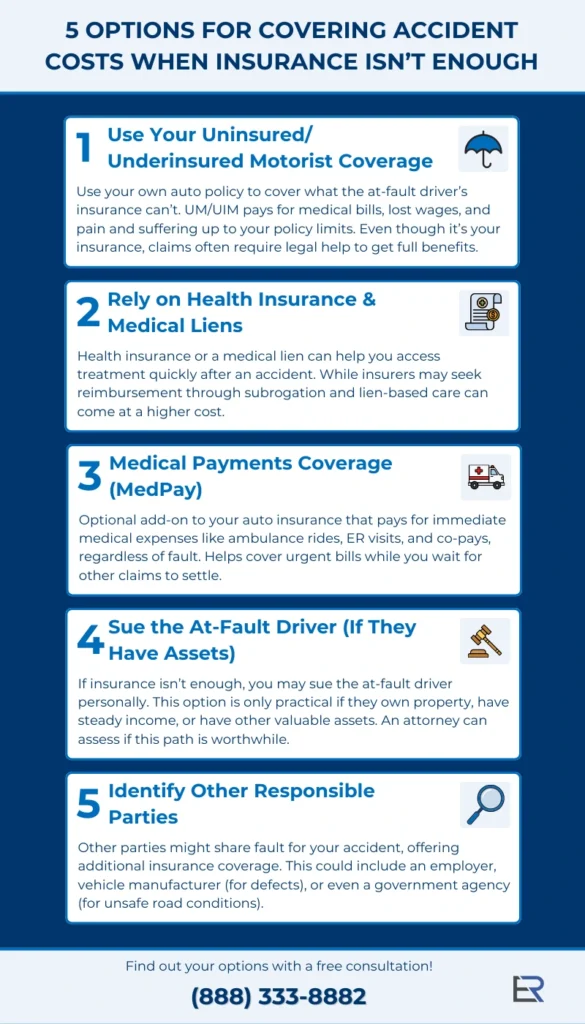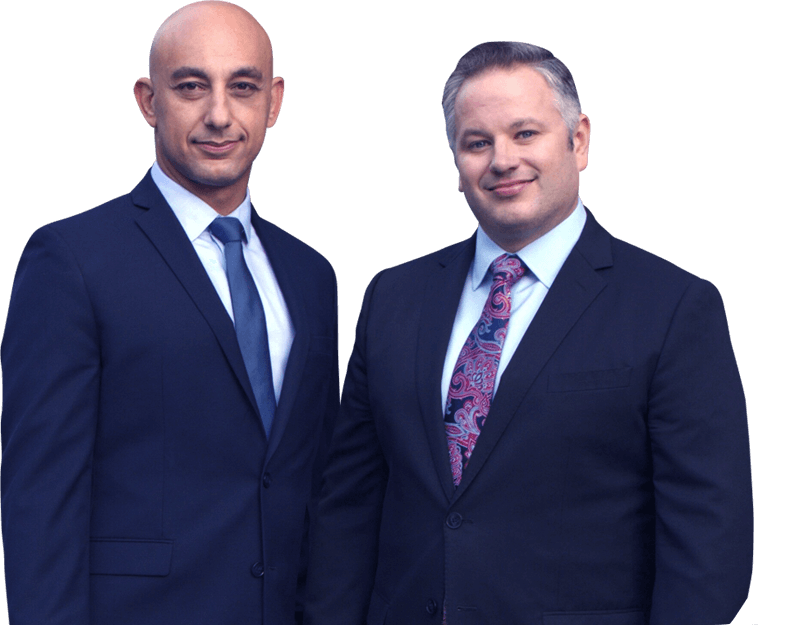According to the Insurance Information Institute, 17% of drivers in California were uninsured in 2022, and many more carry only the minimum required coverage. That means the chances of being hit by someone with little or no insurance are higher than you might expect. Even when a driver does have insurance, it may not be enough to cover your medical bills, lost income, or other damages. If you’re wondering what to do when the other driver’s insurance isn’t enough to pay for your injuries, you’re not alone. We’re here to help you understand your legal options and what steps to take after a serious crash.
Understanding Liability Insurance Limits (and Why They Fall Short)
Before exploring your options, it helps to know how auto liability insurance works. In California, drivers must carry a minimum of $30,000 per person and $60,000 per accident for bodily injury liability starting in 2025. This insurance pays for damages when the driver causes an accident.
However, these limits often fall short after serious crashes. A single surgery, hospitalization, or long-term rehab can easily exceed these amounts. Once the at-fault driver’s insurance policy limits are reached, their insurer is no longer required to pay additional compensation. Any remaining costs become the responsibility of the at-fault driver, leaving you to figure out what to do when the other driver’s insurance isn’t enough to pay for all your damages.
5 Options When the Other Driver’s Insurance Isn’t Enough

Realizing the other driver’s insurance won’t cover your injuries is frustrating, but it doesn’t mean you’re out of options. Alternative paths are available to help you secure fair compensation. Below are 5 key options to help you recover the remaining costs after an accident.
1. Uninsured/Underinsured Motorist (UM/UIM) Coverage
Uninsured/underinsured motorist (UM/UIM) coverage is one of the most important protections you can have after a car accident. It’s part of your own auto insurance policy and is designed to protect you when the at-fault driver either has no insurance or doesn’t carry enough to cover your medical bills, lost wages, and other damages. Without UM/UIM coverage, you could be left paying out of pocket for someone else’s mistake.
Benefits of UM/UIM coverage include:
- Pays for medical expenses, lost wages, and pain and suffering.
- Covers the difference between what the at-fault driver’s insurance pays and your total damages (up to your policy limits).
For example, if the at-fault driver’s liability insurance covers only $30,000 and your total damages are $100,000, your underinsured motorist coverage could pay the remaining $70,000, provided your policy limits are high enough.
Even though this is your insurance, you may still face resistance when making a claim. Insurance companies often try to minimize payouts. An experienced car accident attorney can help ensure you receive the full benefits you’re entitled to.
Recommended Reading:
- Do I Have An Uninsured/Underinsured Motorist Claim?
- How to Handle a Denied Uninsured or Underinsured Motorist Claim
2. Medical Payments Coverage (MedPay) for Immediate Expenses
Medical Payments Coverage, commonly known as MedPay, is an optional benefit you can add to your auto insurance policy. It helps cover immediate medical expenses after a car accident, regardless of who was at fault. While some states require drivers to carry MedPay, California does not mandate it. However, having MedPay can provide critical financial relief while larger insurance claims are being resolved.
Common Medical Costs Covered by MedPay:
- Ambulance rides
- Emergency room visits
- Initial medical treatments
- Out-of-pocket medical costs (like co-pays or deductibles)
MedPay policies often cover between $1,000 and $10,000, but even that amount can provide critical financial support after an accident. It helps cover urgent medical bills and keeps you financially stable while you wait for other insurance claims to be settled.
3. Health Insurance and Medical Liens to Manage Accident Costs

If the at-fault driver’s insurance doesn’t cover all your medical expenses, health insurance or a medical lien may help you get the care you need without delay. Both can be valuable tools, but each comes with important conditions.
Covering Car Accident Injuries with Health Insurance
Health insurance can help cover treatments related to your injuries, such as hospital stays, surgeries, doctor visits, prescription medications, and physical therapy. One of its biggest advantages is that it provides immediate access to medical care, allowing you to begin your recovery without waiting for your personal injury claim to resolve.
However, most policies include a subrogation clause, which allows your insurer to seek reimbursement from your settlement. In California, the made whole doctrine may limit this right, protecting you from having to repay the insurer until you’ve been fully compensated for your losses. It’s important to review your health plan carefully. If you’re unsure about your policy’s terms, a personal injury attorney can explain your rights and help protect your financial recovery.
Paying for Medical Care with a Lien After an Accident
If you don’t have health insurance or prefer not to use it, you may be able to receive care through a medical lien. This arrangement allows a healthcare provider to treat you now and get paid later, directly from your settlement once your case is resolved.
A medical lien can be a helpful way to access treatment quickly without having to pay out of pocket. It allows you to focus on recovery while your case is pending. While treatment costs under a lien may be higher than standard insurance rates, many providers who accept liens offer excellent care and flexible billing arrangements. Choosing a reputable provider ensures you receive quality care and helps protect your overall recovery.
Why Legal Help Matters
Medical liens and subrogation claims may be deducted from your final compensation, but with experienced legal guidance, these amounts are often negotiable and may be reduced. A personal injury attorney will fight to protect your settlement and ensure your compensation covers all aspects of your recovery.
Recommended Reading:
- Treatment with Health Insurance Versus On A Doctor’s Lien
- How to Pay Medical Bills after a Car Accident Injury
4. Sue the At-Fault Driver Personally (If They Have Assets)
If the at-fault driver’s insurance and your own coverage aren’t enough, you may consider filing a personal lawsuit against the driver. This option allows you to pursue compensation directly from their personal assets.
Suing the at-fault driver may be worthwhile if:
- The driver owns property, businesses, or valuable assets.
- The driver has a steady income that could satisfy a court judgment.
If the driver has no assets or financial resources, suing them may not be worthwhile, even if you win the case. An attorney can investigate the driver’s ability to pay and advise you on whether this path makes sense.
5. Identify Other Responsible Parties for Additional Compensation
The at-fault driver might not be the only one legally responsible for your accident. A comprehensive investigation may uncover additional parties who share liability. This can open the door to larger insurance policies and deeper financial resources.
Potential third-party claims may include:
- Employer Liability: If the driver was working (delivery driver, rideshare, etc.), their employer’s commercial insurance may cover the damages.
- Vehicle Manufacturer: Defects like brake failure or airbag malfunctions could lead to a product liability claim.
- Government Entities: Poor road conditions, missing signs, or faulty traffic signals could make a city, county, or state agency partially responsible.
These additional claims can make a significant difference in cases where the at-fault driver’s liability coverage is insufficient.

What Happens If the Other Driver Is Completely Uninsured?
While insufficient coverage is a common issue, some drivers operate vehicles without any coverage. This is surprisingly common, despite state requirements for liability coverage.
In these cases:
- Uninsured Motorist Coverage (UM) becomes essential.
- If you have UM coverage, it acts as a substitute for the at-fault driver’s nonexistent insurance.
- If you don’t have UM coverage, you may need to explore third-party liability claims or health insurance for medical expenses.
- In hit-and-run accidents, UM coverage also protects you when the at-fault driver is never identified.
Because uninsured drivers present significant challenges, having UM coverage before an accident is important. An attorney can help file these claims and push back if your insurer undervalues your losses.
Why Legal Help Matters in Underinsured Accident Cases
Navigating multiple insurance claims, medical liens, and potential lawsuits can be overwhelming. Insurance companies, whether it’s the at-fault driver’s insurer or your own, may try to minimize what they pay. Having an experienced car accident attorney on your side ensures that you explore every option for compensation. Our attorneys are here to guide you through what to do when the other driver’s insurance isn’t enough, so you’re not left navigating complex claims on your own.
At El Dabe Ritter Trial Lawyers, we will:
- Review your insurance policies and identify available coverages.
- Handle negotiations with all insurance companies.
- Manage medical liens to protect your settlement.
- Investigate additional third-party responsibility.
- File lawsuits when needed to recover full compensation.
Schedule Your Free Consultation and Explore Every Option!

If you’ve been injured in a car accident and just learned that the other driver’s insurance isn’t enough to cover your medical bills, lost wages, and other expenses, don’t panic. You have more options than you might think.
You’re not alone! At El Dabe Ritter Trial Lawyers, we assist clients every day who are dealing with limited insurance coverage after an accident. From handling uninsured/underinsured motorist claims to negotiating medical liens and identifying other responsible parties, our team knows how to fight for the compensation you deserve. Your consultation is completely free, and you don’t pay us unless we win your case. Reach out today to protect your future!
Disclaimer: The information provided in this blog post is not intended as legal advice and should not be relied upon as such. You should consult with an experienced attorney for advice on your specific situation.
